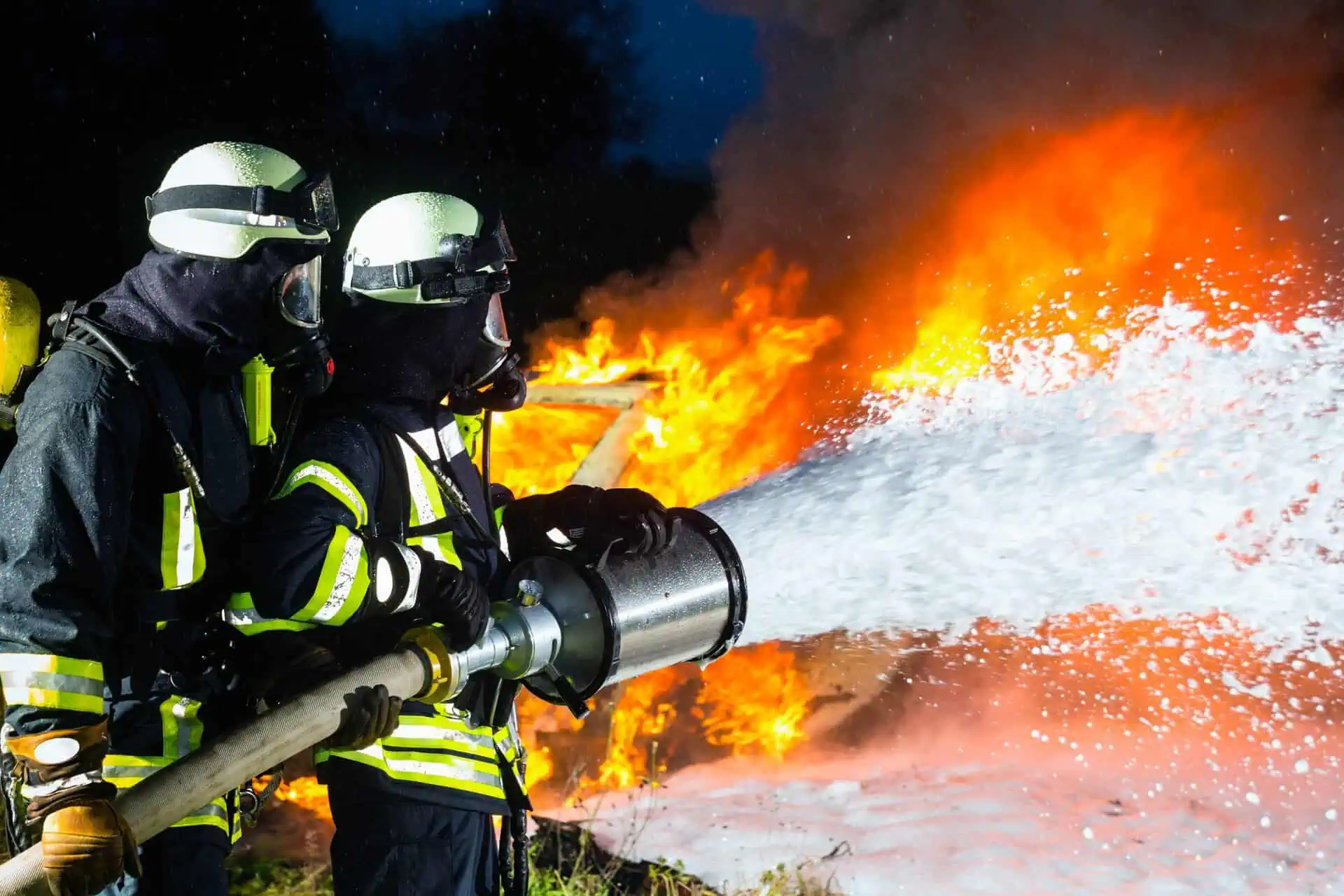Which AFFF Manufacturers Are Named In The AFFF Lawsuits?
- Last Updated: June 12th, 2025

Attorney Jessica Paluch-Hoerman, founder of TruLaw, has over 28 years of experience as a personal injury and mass tort attorney, and previously worked as an international tax attorney at Deloitte. Jessie collaborates with attorneys nationwide — enabling her to share reliable, up-to-date legal information with our readers.
Legally Reviewed
This article has been written and reviewed for legal accuracy and clarity by the team of writers and legal experts at TruLaw and is as accurate as possible. This content should not be taken as legal advice from an attorney. If you would like to learn more about our owner and experienced injury lawyer, Jessie Paluch, you can do so here.
Fact-Checked
TruLaw does everything possible to make sure the information in this article is up to date and accurate. If you need specific legal advice about your case, contact us by using the chat on the bottom of this page. This article should not be taken as advice from an attorney.
Key takeaways:
- AFFF Lawsuits, represented by seasoned attorneys, argue that these manufacturers exposed workers and consumers to harmful substance
- The timeline for an average lawsuit varies greatly based on several factors.
- The impact of AFFF on firefighters' health and its legal implications cannot be overstated.
Which AFFF Manufacturers Are Named in the AFFF Lawsuits?
Question: Which AFFF Manufacturers are named in the AFFF lawsuits?
Answer: Several companies, including major manufacturers like 3M, DuPont, and Chemguard, are named as defendants in ongoing AFFF lawsuits.
These companies are accused of producing and distributing Aqueous Film-Forming Foam (AFFF) containing harmful PFAS chemicals, which are believed to have contaminated water sources and contributed to severe health risks.
On this page, we will take a closer look at the AFFF manufacturers involved in these lawsuits, potential AFFF lawsuit settlement amounts, who qualifies to file an AFFF lawsuit, and much more.
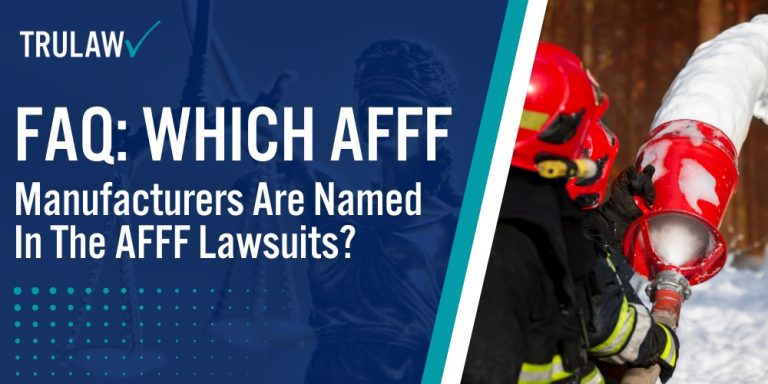
Intro to the AFFF Lawsuits
AFFF firefighting foam has been associated with a range of health problems, including an increased risk of cancer.
Lawsuits have been filed against various manufacturers, and many of these claims have been consolidated into the AFFF Firefighting Foam multidistrict litigation (MDL).
The following AFFF manufacturers have been named as defendants in the AFFF lawsuits:
- Tyco Fire Products
- Corteva Inc.
- BASF Corp.
- 3M
- DuPont
- Chemours
- Arkema Inc.
- Dynax Corp.
- And several other AFFF manufacturers
These manufacturers are potentially responsible for exposing military personnel, firefighters, and other workers to harmful chemicals through AFFF, which contains PFAS substances.
These chemicals have been linked to serious health conditions, including cancer.
If you or a loved one were exposed to AFFF and developed cancer or other health issues, you may be eligible to pursue legal action.
Contact TruLaw by using the chat on this page to receive an instant case evaluation that will determine if you qualify to join others in filing an AFFF lawsuit today.
Table of Contents
AFFF Manufacturers Involved in the AFFF Firefighting Foam MDL
The widespread use of AFFF (Aqueous Film-Forming Foam) in firefighting has become a growing concern due to the potential health risks linked to its chemical components.
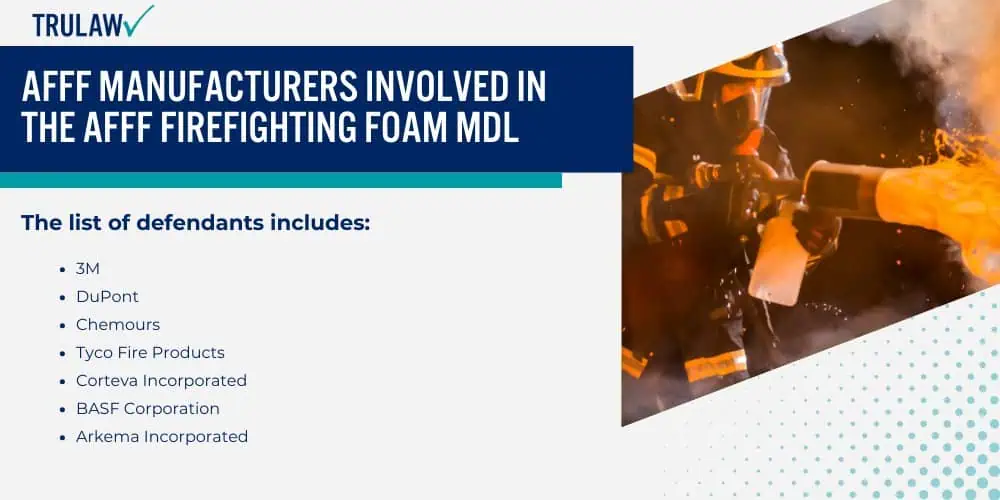
Ongoing litigation has brought attention to the dangers associated with exposure to AFFF, particularly the elevated risk of developing cancer.
Who Are the Defendants in These Lawsuits?
Several major manufacturers of AFFF have been named as defendants in the ongoing AFFF multi-district litigation (MDL).
These companies, many of which are well-known in both industrial and consumer markets, have been among the largest producers of AFFF over the years.
The list of defendants includes:
- 3M
- DuPont
- Chemours
- Tyco Fire Products
- Corteva Incorporated
- BASF Corporation
- Arkema Incorporated
- Dynax Corporation
- Chubb National Foam Incorporated
- UTC Fire & Security Americas
- AGC Chemicals Americas
- Kidde-Fenwal
- Clariant Corporation
- Carrier Global Corporation
Why Are These Manufacturers Being Sued?
These manufacturers face litigation due to their alleged role in exposing the public to harmful chemicals.
The lawsuits claim that these companies were aware of the health risks posed by AFFF’s toxic chemicals but did not take adequate steps to mitigate the dangers.
The core accusations revolve around two main claims:
- Knowledge without Action: The defendants allegedly knew about the potential health risks associated with AFFF but failed to take appropriate action to protect the public.
- Failure to Warn: The manufacturers did not provide sufficient warnings regarding the dangers of their products, leaving individuals exposed to serious risks.
Potential Outcomes of the Ongoing AFFF Litigation
If the AFFF litigation results in favorable rulings for the plaintiffs, the manufacturers may be held liable on the following grounds:
- Failure to Act: The defendants may be found to have had knowledge of the risks associated with AFFF but did not take the necessary steps to protect users or the public.
- Inadequate Warnings: Manufacturers could be held responsible for not warning individuals about the known dangers associated with AFFF exposure.
If these claims are upheld, the manufacturers could be required to compensate those who have filed lawsuits for the harm caused by exposure to AFFF.
Have you been affected?
If you or a loved one has been diagnosed with cancer or other health conditions following exposure to AFFF, you may qualify to take part in the AFFF lawsuit.
Contact TruLaw for Legal Assistance Today
TruLaw is working to provide individuals affected by AFFF exposure with the resources they need to explore their legal options.
If you’re unsure of your eligibility, you can use the chatbot on this page to instantly determine if you qualify for the AFFF firefighting foam lawsuit.
Your health and well-being are our priority.
Overview of AFFF Firefighting Foam Lawsuits
AFFF firefighting foam lawsuits center on product liability claims against companies involved in the manufacture or distribution of AFFF foam.
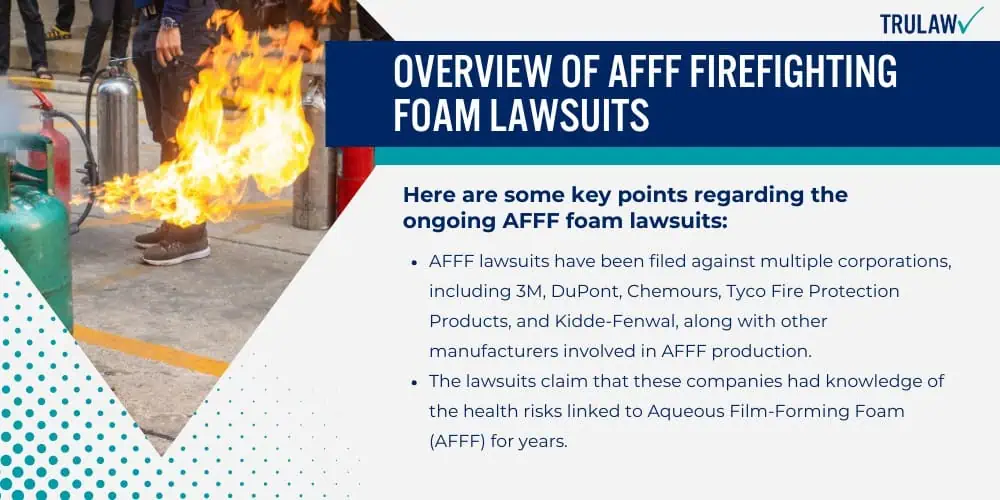
These legal actions focus on the use of per- and polyfluoroalkyl substances (PFAS), synthetic chemicals that have been linked to several health concerns, including cancer, thyroid disorders, and fertility issues.
The lawsuits allege that companies were aware of the dangers posed by PFAS-containing foams but failed to adequately warn their employees or the public about the potential health risks.
Additionally, AFFF lawsuits hold these companies accountable for the health problems experienced by individuals exposed to AFFF foam and PFAS contamination.
While the lawsuits are still ongoing, with no confirmed monetary compensation for plaintiffs at this time, they have already helped raise public awareness about the dangers associated with PFAS exposure.
Here are some key points regarding the ongoing AFFF foam lawsuits:
- AFFF lawsuits have been filed against multiple corporations, including 3M, DuPont, Chemours, Tyco Fire Protection Products, and Kidde-Fenwal, along with other manufacturers involved in AFFF production.
- The lawsuits claim that these companies had knowledge of the health risks linked to Aqueous Film-Forming Foam (AFFF) for years.
- The claims also argue that individuals exposed to AFFF foam have suffered various health issues, including cancers, thyroid disorders, and reduced fertility.
- The lawsuits are ongoing, and potential compensation for affected individuals has not yet been determined.
- In 2019, the lawsuits were consolidated into a multidistrict litigation (MDL), filed in the United States District Court for the District of South Carolina under MDL 2873.
These lawsuits play an important role in highlighting the health risks posed by PFAS, as the litigation progresses in holding manufacturers accountable for their role in PFAS exposure.
Health Issues Linked to AFFF Firefighting Foam Exposure
The manufacturers of AFFF firefighting foam may be held accountable for exposing military personnel, employees, and the general public to serious health risks.
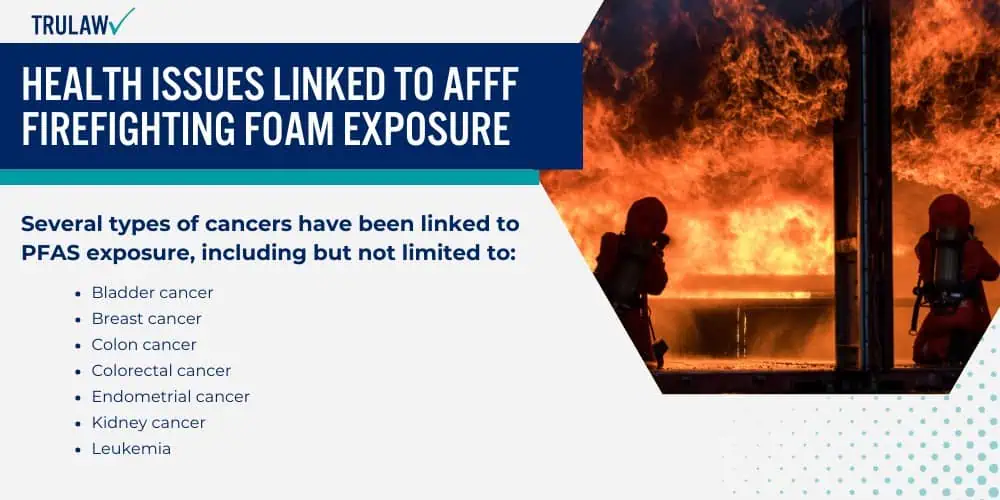
To understand why these companies could be liable, it’s important to explore the issues connected to AFFF firefighting foam.
At the core of AFFF’s association with various health and environmental concerns are the PFAS chemicals found in these products.
These “forever chemicals” are a key reason AFFF poses such risks.
Health Risks Associated with “Forever Chemicals”
PFAS chemicals, used in the production of AFFF firefighting foam, specifically include fluorosurfactants.
Over the years, agencies such as the Environmental Protection Agency (EPA) and the Environmental Working Group have raised serious concerns about these substances, linking PFAS to a variety of health problems, including cancer.
The EPA has identified cancer among the potential health risks associated with PFAS exposure.
Several types of cancers have been linked to PFAS exposure, including but not limited to:
- Bladder cancer
- Breast cancer
- Colon cancer
- Colorectal cancer
- Endometrial cancer
- Kidney cancer
- Leukemia
- Liver cancer
- Lymphoma
- Mesothelioma
- Multiple Myeloma
- Non-Hodgkin Lymphoma
- Ovarian cancer
- Pancreatic cancer
- Prostate cancer
- Rectal cancer
- Testicular cancer
- Thyroid cancer
Bio-accumulative Nature of PFAS Chemicals
PFAS chemicals are notorious for their bioaccumulation, meaning they can remain in the human body for an extended period without breaking down.
This persistence is a health risk concern and a key reason people are pursuing AFFF firefighting foam cancer lawsuits.
The longer these chemicals stay in the body, the greater the risk of them reaching toxic levels and causing serious health issues.
Toxic Effects of Forever Chemicals
PFAS chemicals have been classified as toxic, with links to various health complications.
According to the Endocrine Society, PFAS can disrupt endocrine function, leading to thyroid disease and metabolic disorders.
Additionally, research from the Agency for Toxic Substances and Disease Registry (ATSDR) has shown that PFAS exposure in lab animals resulted in liver damage, immune system suppression, and even birth defects and developmental issues.
Environmental Contamination from PFAS
The Environmental Protection Agency (EPA) has long been aware of the environmental dangers posed by PFAS chemicals.
According to the EPA, PFAS are among the most concerning pollutants, contaminating soil, water, and even entering the food chain.
One major contributor to this environmental contamination is the use and disposal of AFFF firefighting foam.
PFAS chemicals are highly toxic to both plants and animals, and their presence in soil and water can create long-term health hazards for the public, including contamination of food and drinking water sources.
Scientific Research Linking Aqueous Film Forming Foams to Serious Health Problems
Numerous studies have identified a correlation between AFFF exposure and a range of serious health conditions, including cancer and endocrine disorders.
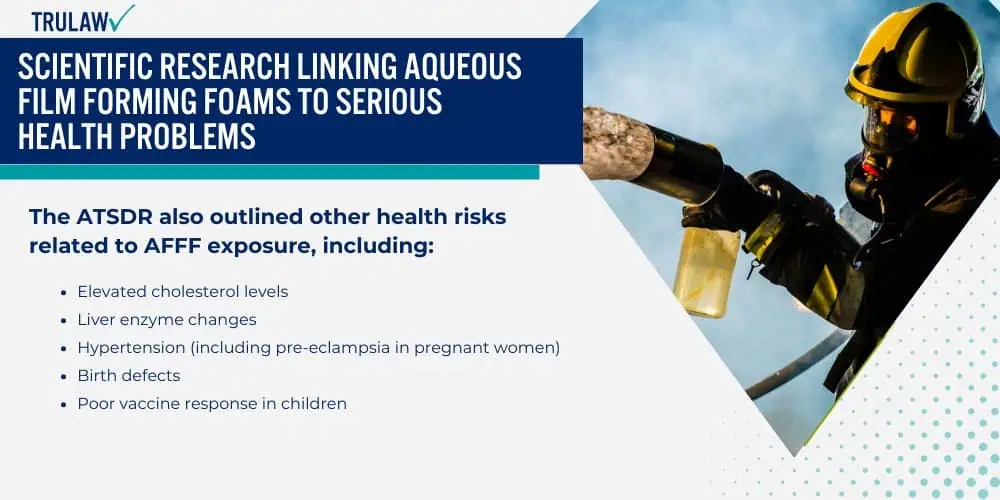
For example, a study titled “Exposure to perfluoroalkyl substances in a cohort of women firefighters and office workers in San Francisco” found that firefighters were at a higher risk of developing cancer compared to the general population, likely due to PFAS exposure.
This study is one of many that suggest a connection between exposure to AFFF and the development of cancer, among other illnesses.
In recent years, additional research has emerged with scientific evidence linking AFFF to specific cancers.
A 2021 epidemiological review highlighted two types of cancers frequently found in individuals exposed to PFAS chemicals:
- Kidney cancer
- Testicular cancer
The CDC’s Agency for Toxic Substances and Disease Registry (ATSDR) also reported similar findings.
In 2022, the ATSDR confirmed that cancer is one of the potential health risks associated with PFAS exposure.
The ATSDR also outlined other health risks related to AFFF exposure, including:
- Elevated cholesterol levels
- Liver enzyme changes
- Hypertension (including pre-eclampsia in pregnant women)
- Birth defects
- Poor vaccine response in children
In addition to these risks, research has shown that PFAS chemicals can disrupt hormonal health.
According to a 2021 study, PFAS compounds interfere with endocrine functions by binding to glands and receptors, which can suppress normal hormonal responses.
This disruption can lead to imbalances that affect metabolism and overall health.
The health issues tied to PFAS exposure, particularly in AFFF products, are real, and companies responsible for these products may be held liable.
If you or a loved one has developed cancer or another illness after exposure to toxic firefighting foam, reach out to our team at TruLaw to learn more about your legal options.
You can use the chat on this page for an instant case evaluation to determine if you qualify to file an AFFF lawsuit today.
Previous Legal Actions Against AFFF Manufacturers
Legal actions have already been initiated against several manufacturers of AFFF firefighting foam.
These lawsuits allege that the companies were aware of the health risks posed by PFAS chemicals found in AFFF but continued to produce and distribute the fire fighting foam regardless of these dangers.
AFFF-related lawsuits are currently ongoing across multiple states.
The earliest cases began in 2019, and since then, many of these lawsuits have been consolidated into multidistrict litigation (MDL 2873).
As awareness of the potential link between AFFF and cancer increases, more manufacturers have been forced to respond to the legal challenges.
One of the most prominent companies involved in these lawsuits, 3M, has consistently denied responsibility, arguing that the connection between the PFAS content in AFFF and cancer risk remains unproven.
This stance is echoed by several other manufacturers facing similar lawsuits.
The lawsuits have also impacted numerous companies.
For example, on May 23, 2023, Kidde-Fenwal — another AFFF manufacturer named in these cases — filed for bankruptcy under Section 11, largely due to the number of pending claims.
Despite this, the courts have allowed the company to continue operating to meet any potential financial obligations related to the lawsuits.
We continue to monitor the progress of these cases as new developments emerge in the ongoing litigation against AFFF manufacturers.
A Brief History of Aqueous Film Forming Foam and Its Use
Aqueous Film-Forming Foam (AFFF) has been a key tool in firefighting for decades, especially for extinguishing Class B fires caused by flammable liquids.
Developed in the 1960s as a joint effort between the United States Navy and 3M Corporation, AFFF was quickly adopted by military branches and considered a major advancement in the firefighting foam sector.
Its widespread use began after a notable incident aboard the USS Forrestal, where AFFF played a key role in controlling a dangerous fire outbreak.
By the 1970s, AFFF had expanded beyond military use, becoming a common firefighting solution in military facilities, airports, chemical plants, and other environments where flammable liquid fires posed a threat.
For many years, it was considered the “gold standard” in fire suppression for these types of fires.
However, by the early 2000s, concerns emerged about the environmental and health impacts of AFFF.
The foam contains PFAS chemicals, known as “forever chemicals,” which persist in the environment and have been linked to serious health risks, including long-term exposure hazards for humans.
TruLaw: Your AFFF Firefighting Foam Law Firm
Exposure to aqueous film-forming foam (AFFF) can lead to serious health risks, including an increased likelihood of cancer and other related conditions.
If you have been exposed to AFFF and later developed cancer or other health concerns, you may qualify to file an AFFF lawsuit.
You can use the chatbot on this page to instantly see if you are eligible for the firefighting foam cancer lawsuit.
The firefighting foam attorneys at TruLaw and our partner law firms are dedicated to supporting clients through the AFFF claims process.
For further details or updates about the AFFF lawsuit, visit this page or contact us to discuss your case.
AFFF Lawsuit Frequently Asked Questions
-
Which AFFF Manufacturers Are Named in the AFFF Lawsuits?
Over the years, the use of AFFF (aqueous film-forming foam) in firefighting has raised concerns due to its potential health risks.
Recent lawsuits have highlighted the dangers associated with exposure to this foam, particularly the elevated risk of cancer.
Who are the Defendants?
Several major manufacturers of AFFF firefighting foam have been named as defendants in the ongoing multidistrict litigation (MDL) related to AFFF exposure.
Many of these companies are well-known and have historically been leading producers of AFFF products.
The list of manufacturers named in the lawsuits includes:
- Carrier Global Corporation
- Kidde-Fenwal
- Chubb National Foam Incorporated
- Arkema Incorporated
- 3M
- Tyco Fire Products
- BASF Corporation
- Chemours
- Clariant Corporation
- AGC Chemicals Americas
- DuPont
- Corteva Incorporated
- Dynax Corporation
- UTC Fire & Security Americas
Why are these AFFF manufacturers being sued?
These AFFF manufacturers face legal action for allegedly endangering public health.
The litigation centers on claims that these companies were aware of the health risks posed by the toxic chemicals in their AFFF products.
Despite this knowledge, it is alleged that they failed to warn the public or take necessary precautions to reduce these risks.
Potential Outcomes of the Litigation
If the AFFF lawsuits result in favorable rulings for plaintiffs, manufacturers could be held responsible for two key reasons:
- Failure to Act: The defendants allegedly knew about the potential dangers of their products but did not take steps to mitigate the risks.
- Failure to Warn: The companies are accused of not providing adequate warnings about the harmful effects of AFFF.
As a result, manufacturers may be required to compensate those who claim harm from AFFF exposure.
Have you been affected?
If you or a loved one developed cancer or other health conditions following AFFF exposure, you may be eligible to join the AFFF lawsuit.
Contact TruLaw Today
TruLaw offers a free consultation for individuals who believe they’ve been impacted by AFFF exposure.
You can use the chatbot on this page to instantly see if you qualify for the AFFF firefighting foam lawsuit.
-
Is AFFF still being used?
Aqueous film-forming foam (AFFF) continues to be used in certain specialized environments, such as on military sites.
The US Department of Defense is actively working to phase out PFAS-containing firefighting foams and replace them with safer alternatives.
Meanwhile, the National Fire Protection Association has released a roadmap to help fire protection agencies transition away from AFFF and adopt PFAS-free firefighting foam.
-
What health problems are linked to AFFF exposure?
Exposure to toxic chemicals in AFFF has been linked to various cancers and other health issues.
Health problems associated with AFFF exposure include, but are not limited to:
- Bladder cancer
- Breast cancer
- Colon cancer
- Colorectal cancer
- Endometrial cancer
- Kidney cancer
- Leukemia
- Liver cancer
- Lymphoma
- Mesothelioma
- Multiple Myeloma
- Non-Hodgkin Lymphoma
- Ovarian cancer
- Pancreatic cancer
- Prostate cancer
- Rectal cancer
- Testicular cancer
- Thyroid cancer
- Thyroid disease
- Ulcerative Colitis
- Birth defects and other reproductive issues
- Developmental problems
- Heart disease
- Hormonal imbalances
- Immune system disorders
- Liver damage
- Neuroendocrine tumors
- Reproductive issues
- Skin and eye irritation
- Other health complications
-
What are PFAS chemicals (forever chemicals)?
PFAS chemicals, also known as per- and polyfluoroalkyl substances, are synthetic compounds used in a wide array of products for their ability to resist water, grease, and stains.
Commonly found in items like non-stick cookware, stain-resistant fabrics, and firefighting foams, PFAS are known as “forever chemicals” because they do not easily break down in the environment or the human body.
This persistence has led to growing concerns about their potential health effects and their long-lasting presence in the environment .
-
Do you qualify for the AFFF lawsuit?
If you or a loved one has been exposed to AFFF and developed cancer or other health issues, you may be eligible to file an AFFF lawsuit.
Contact TruLaw for a free consultation to discuss your eligibility and legal options.
You can use the chatbot on this page to instantly determine if you qualify for the AFFF firefighting foam lawsuit.
Whether you are a civilian or military firefighter, chemical plant worker, or experienced AFFF exposure in another setting, you may be able to file a claim against the manufacturers responsible for your exposure.
-
What is the average AFFF lawsuit settlement amount?
As the AFFF lawsuits are still ongoing, no settlement amounts have been determined.
However, attorneys estimate that settlements may range between $20,000 and $600,000 (or more), depending on the strength of the individual case and other relevant factors.
These estimates are not guarantees but rather projections based on past settlements in similar mass tort cases involving cancer diagnoses.
For more specific guidance on what you might expect from an AFFF lawsuit, speak with an attorney to evaluate your case.
-
Is there an AFFF class action lawsuit?
No, there is no class action lawsuit for personal injury claims related to AFFF exposure.
Instead, individual lawsuits have been consolidated into a multidistrict litigation (MDL), which is being handled by the US District Court for the District of South Carolina.
While MDL is similar to class action in that cases are grouped together, plaintiffs in MDL retain their individual claims and can receive compensation based on the specific circumstances of their cases.
Some law firms may refer to this litigation as an “AFFF Class Action MDL,” but this terminology is incorrect.
The correct legal process for these cases is multidistrict litigation, not class action.
-
What is the difference between AFFF foam and Compressed Air Foam Systems (CAFS)?
AFFF (Aqueous Film-Forming Foam) and CAFS (Compressed Air Foam Systems) are both types of firefighting foam concentrates, but they have distinct characteristics and applications:
AFFF
- Water-based foam that forms a film on surfaces.
- Used for flammable liquids, gases, and certain solids.
- Contains harmful PFAS chemicals.
CAFS
- Foam created by mixing air and foam concentrate.
- Effective for interior fires and structural fires.
- Generally considered safer than AFFF due to lower PFAS content, but may still contain trace amounts.
To summarize, AFFF and CAFS differ in composition, application methods, and potential health concerns.
The choice between the two depends on the specific fire and available equipment.
-
What is fluorine-free foam?
Fluorine-free foam is a type of firefighting foam that does not contain PFAS (per- and polyfluoroalkyl substances).
PFAS are harmful chemicals linked to health and environmental issues.
Benefits of fluorine-free foam:
- Environmentally friendly: Reduces PFAS contamination.
- Healthier for firefighters: Less exposure to harmful chemicals.
- Regulatory compliant: Meets evolving regulations on PFAS use.
While fluorine-free foams offer a safer alternative, they may still contain other chemicals.
It’s important to consult with experts or regulatory bodies for the most up-to-date information on firefighting foam safety.

Managing Attorney & Owner
With over 25 years of legal experience, Jessica Paluch-Hoerman is an Illinois lawyer, a CPA, and a mother of three. She spent the first decade of her career working as an international tax attorney at Deloitte.
In 2009, Jessie co-founded her own law firm with her husband – which has scaled to over 30 employees since its conception.
In 2016, Jessie founded TruLaw, which allows her to collaborate with attorneys and legal experts across the United States on a daily basis. This hypervaluable network of experts is what enables her to share the most reliable, accurate, and up-to-date legal information with our readers!
Additional AFFF Lawsuit resources on our website:
Here, at TruLaw, we’re committed to helping victims get the justice they deserve.
Alongside our partner law firms, we have successfully collected over $3 Billion in verdicts and settlements on behalf of injured individuals.
Would you like our help?
At TruLaw, we fiercely combat corporations that endanger individuals’ well-being. If you’ve suffered injuries and believe these well-funded entities should be held accountable, we’re here for you.
With TruLaw, you gain access to successful and seasoned lawyers who maximize your chances of success. Our lawyers invest in you—they do not receive a dime until your lawsuit reaches a successful resolution!
AFFF Lawsuit claims are being filed against manufacturers of aqueous film-forming foam (AFFF), commonly used in firefighting.
Claims allege that companies such as 3M, DuPont, and Tyco Fire Products failed to adequately warn users about the potential dangers of AFFF exposure — including increased risks of various cancers and diseases.
Depo Provera Lawsuit claims are being filed by individuals who allege they developed meningioma (a type of brain tumor) after receiving Depo-Provera birth control injections.
A 2024 study found that women using Depo-Provera for at least 1 year are five times more likely to develop meningioma brain tumors compared to those not using the drug.
Suboxone Tooth Decay Lawsuit claims are being filed against Indivior, the manufacturer of Suboxone, a medication used to treat opioid addiction.
Claims allege that Indivior failed to adequately warn users about the potential dangers of severe tooth decay and dental injuries associated with Suboxone’s sublingual film version.
Social Media Harm Lawsuits are being filed against social media companies for allegedly causing mental health issues in children and teens.
Claims allege that companies like Meta, Google, ByteDance, and Snap designed addictive platforms that led to anxiety, depression, and other mental health issues without adequately warning users or parents.
Transvaginal Mesh Lawsuits are being filed against manufacturers of transvaginal mesh products used to treat pelvic organ prolapse (POP) and stress urinary incontinence (SUI).
Claims allege that companies like Ethicon, C.R. Bard, and Boston Scientific failed to adequately warn about potential dangers — including erosion, pain, and infection.
Bair Hugger Warming Blanket Lawsuits involve claims against 3M — alleging their surgical warming blankets caused severe infections and complications (particularly in hip and knee replacement surgeries).
Plaintiffs claim 3M failed to warn about potential risks — despite knowing about increased risk of deep joint infections since 2011.
Baby Formula NEC Lawsuit claims are being filed against manufacturers of cow’s milk-based baby formula products.
Claims allege that companies like Abbott Laboratories (Similac) and Mead Johnson & Company (Enfamil) failed to warn about the increased risk of necrotizing enterocolitis (NEC) in premature infants.
Here, at TruLaw, we’re committed to helping victims get the justice they deserve.
Alongside our partner law firms, we have successfully collected over $3 Billion in verdicts and settlements on behalf of injured individuals.
Would you like our help?
